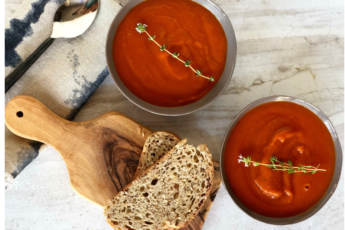NOTE: I’ve partnered with The Glutamate Association for many years, but this post is strictly my own – all based on science and any views are my own.
I love dispelling food myths. There’s so much “fear of food”, and how food myths get started is as varied as the myths themselves.
No food or ingredient illustrates this better than monosodium glutamate, or MSG. Based on a physician’s single letter to the editor of a medical journal, back in 1969, noting symptoms after having eaten in a Chinese restaurant. Of the possible causes he suggested, the only one that stuck was MSG: Chinese Restaurant Syndrome was born and went viral immediately – WAY before the internet!
MSG had been used for decades with no reported issues, but suddenly fear of MSG dominated and all hell broke loose, launching dozens of research studies on the effects of MSG.
Bottom line, years of clinical studies showed nothing: no connection to headaches, palpitations or any of the symptoms attributed to MSG. A new website, knowMSG.com is loaded with the facts — and lots of delicious recipes (including for the dishes you see here), demonstrating what MSG can do to enhance the flavor of healthful food.
MSG Is Simple: 2 Components
It’s just sodium and glutamate, and we have BOTH in our bodies at all times. Sodium is an electrolyte that’s critical for numerous body processes, including the nervous system, heart and circulatory function, every organ needs sodium. Yes, we get too much, but MSG can actually help there. Keep reading.
Glutamate, or glutamic acid, is an amino acid, one of the building blocks of protein. Glutamate is in all protein foods, but we don’t need to get it from protein because our bodies MAKE IT THEMSELVES – to the tune of about 50 grams a day. That’s why it’s not an “essential” amino acid. It’s far more than you’d ever get from eating anything with MSG.
True Or False: “Umami” = Glutamate
TRUE! Chefs speak about “umami”, the fifth taste, and it’s what every chef wants more of in food, that intensity of flavor that makes food of all cuisines so delicious. Parmesan cheese, tomatoes, mushrooms, anchovies, seaweed, beef, even broccoli — they’re they’re all NATURALLY loaded with glutamate, giving them a savory umami taste.
It’s always been in breast milk, too. Human breast milk has 10 times more free glutamate than cow’s milk — maybe to make it appealing to infants, so they’ll feed more readily?
10 Reasons Why This Nutritionist Likes MSG:
- It’s simple, just 2 components, sodium and glutamate.
- Glutamate has many roles in the body, but mostly fuels the functions of our digestive and immune systems – that’s why 95% if it is in our gut.
- Virtually ALL credible research shows no ill effects from MSG.
- Safety of MSG is backed by science, and confirmed by all global regulatory bodies. MSG is safe, period.
- It’s LOWER in sodium than salt! Gram-for-gram, it has 62% less sodium than sodium chloride (the familiar salt used in cooking).
- By swapping half a recipe’s salt for MSG, you intensify flavor BETTER but also lower the sodium. Lower sodium, but enhanced taste — I like “win-wins”.
- Glutamate is in many foods I don’t want to live without: parmesan cheese, tomatoes, eggplant, mushrooms, and many more. These foods are loved my many cultures for their unique flavor, and glutamate is an important part of that flavor.
- Nearly everyone needs to eat more vegetables. MSG can help us get there by amping up the flavor of those veggies. Another win-win.
- MSG is derived from plants, and made through fermentation – much like the process to produce beef, soy sauce or vinegar. What’s fermented? Usually starch from corn, or molasses from sugar cane or sugar beets.
- Glutamate = “umami”. Umami is the 5th taste that all chefs aim for, and is a critical component of the umami taste. Research suggests having umami-rich broth before meals may even help promote healthful food choices and eating behaviors in people at risk for obesity.
Cut to the Chase Take-Away
It’s time to swap food myths for food FACTS. With MSG, the facts TASTE better and are better for us — there’s that win-win again!








